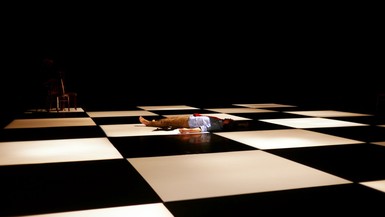 A large checkerboard, a trivial human figure. A large checkerboard, a trivial human figure. The beam of light from a projector appears in front of the viewer instead of just behind. The screen becomes a mirror, reminding the viewer: this is not reality; it’s just a movie. The projector lights up the title, Inland Empire, by David Lynch. At the beginning of Mélanie Demers’s Goodbye, dancer Jacques Poulin-Denis opens with a typical Demers move, a series of statements paradoxical in their juxtaposition: “This is not the show,” he tells us. “Not a flat screen, not reality.” The question that always emerges with Demers is: then what is it? One should never readily believe what the performers are saying. Of course, when Poulin-Denis is claiming, “This is not the show,” he is reminding us of the opposite: this is a show. But does it even matter one way or another? Extreme close-up of a needle on a vinyl record. To say that it’s just music is to undermine the kind of emotional manipulation that art is involved in. 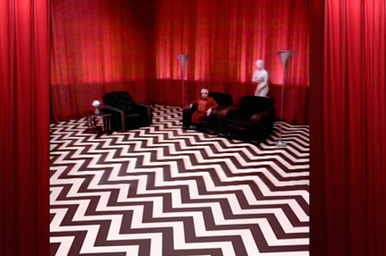 The Black Lodge. The Black Lodge. Even the electric guitar riffs in Goodbye are reminiscent of Lynch, most particularly Angelo Badalamenti’s score for the Twin Peaks series. That’s not to mention the floor, a black-and-white checkerboard of inhuman proportions that dramatizes the space and makes the dancers look trivial, like mere chess pieces. The Black Lodge. A woman watches television, though on it there is nothing but static. Soon, however, the TV image gives way to animated rabbits in their apartment. It could all be in her head. Se faire son cinéma. Do we need to believe that Brianna Lombardo and Poulin-Denis are really a couple to be affected by their dance? Of course not. The moment they interact, the moment they touch, the moment they move together, they enter into a relationship, their actions have consequences. We don’t need to believe that Grace Zabriskie is not Grace Zabriskie. She just needs to walk in, creepy as fuck. If you don’t feel anything, it’s because you’re taking Zabriskie for granted; as real. Suspension of disbelief is a myth. The true power of cinema lies in complete and utter disbelief. Demers is not even trying to pretend. When a performer needs to have tears running down their face, they use eye drops. The microphones they hold are fake, aluminum paper balls on black sticks; the knife, an aluminum paper blade. No one will get hurt. At least not because of objects. No matter how much I hate metaphors, I must recognize that most blades are metaphorical. Artistic ones, always. When Laura Dern gets fake stabbed, she runs down Hollywood Boulevard before falling in front of one of the stars from the Walk of Fame. Lynch will not allow you to believe any of it is real. It doesn’t matter. If you are only affected by things that are real, you’re not human. When Poulin-Denis looks up at the audience while Demers is sucking on his nipple, his reaction is to say, “No, no… It’s not what you think. This is not the show.” The statement is of course hilariously ironic. Demers knows that such a strong image is bound to have an effect on the audience. Would it have any less of an effect if we were to take it in as reality? Of course not. Quite the contrary. 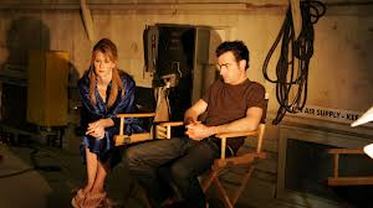 Actors playing actors. Actors playing actors. Whenever Dern and Justin Theroux have a scene together, we never quite know whether they are the actors they are portraying in the movie or the characters the actors are portraying in the movie in the movie. At one point, Dern screams out, “Damn! This sounds like dialogue from our script!” That’s because, of course, it is. First and foremost, and if nothing else, every movie is about people making a movie. Another typical Demers move: when Poulin-Denis is wiping the water off the floor, he is of course doing so for the dancers’ safety; but, by virtue of being performed onstage, the action is also necessarily dramatic. An everyday gesture becomes an artistic one. “Il y a de l’éclairage, des costumes…” he says, laying out the reasons why we might be inclined to think that this is a show. As if those things didn’t exist outside of the theatre… “Is this our set?” Dern asks. She means in the movie in the movie. However, the set only ends up getting used in the movie. Every space is one location scout away from becoming a set. Later, when Poulin-Denis is the one sucking on Lombardo’s nipple, Chi Long shouts, “This is it! This is the show!” Yet the gesture is essentially the same as before. If anything, the gender reversal and repetition (and therefore lack of surprise) have made it more socially acceptable, less dramatic. It’s always been the show, even before Goodbye ever started. The needle on the record, the music, the emotional manipulation... The viewer cries. She cries because she relates with the character Dern is playing. (What in The Wars Timothy Findley beautifully refers to as “shouts of recognition.”) They encounter each other and kiss in the television. Art as a meeting ground, as the space where artist and audience come into contact, where the line between the artistic and the everyday gets blurred. Goodbye. No, really, goodbye. Poulin-Denis keeps telling the audience the show is over, in so many different ways that it becomes comical, yet the audience doesn’t leave. This is still the show. When does it really end? What are the cues? When the stage lights fade out, when the house lights come on, when the performers take a bow, when we clap, when we leave the theatre, when we finally stop thinking about the show… Some shows never end. And, even when shows do end, what awaits us outside the theatre? More metaphorical blades. Theatre.
usine-c.com maydaydanse.ca
0 Comments
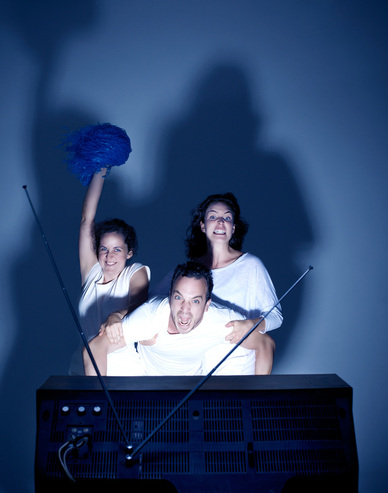 BLEU—VERT—ROUGE, photo de Martin Flamand BLEU—VERT—ROUGE, photo de Martin Flamand Quel est notre rapport à la chose vidéographique? Avec l’omniprésence du médium, qui ouvre et clôt son nouveau spectacle, la chorégraphe Marie Béland se met les deux pieds dans la question. Une création aux trois couleurs cathodiques, en trois épisodes – peut-être le même – utilisant principalement trois médiums différents. BLEU, ou la vidéo D’abord jeu d’ombres – et donc nécessairement de proportions et perspectives – qui s’entremêlent ensuite avec la projection vidéo live des trois danseurs : Simon-Xavier Lefebvre, Marilyne St-Sauveur, et Ashlea Watkin. C’est plus qu’une rencontre des éléments; C’est le réel et l’art(ificiel) qui effacent les lignes, se fondent ensemble, et s’influencent jusqu’à ce qu’on ne sache plus lequel des deux l’on regarde. Les interprètes font dans le jeu d’acteur de Télé-Québec (même si Watkin, comme dans n’importe quel autre spectacle de danse dans lequel elle se trouve, est toujours la meilleure actrice). De façon appropriée, ils sont vêtus de couleurs primaires et secondaires (rouge, bleu, jaune, vert), comme s’ils étaient des adultes retardés dans une émission pour enfants. Leurs corps se découpent sur fond noir, ce qui n’est pas sans rappeler certaines des premières vidéos d’art qui servaient souvent à capter des performances. Dans une galerie, le blanc est l’espace vierge; en vidéo, comme au théâtre, c’est le noir. Devant des images d’Elvis (le vrai ou un imitateur? Il y a une différence?) et d’Arnold à l’ère de Commando, leurs corps se dédoublent en formations psychédéliques, tel une vidéo de Nam June Paik qui s’extase à l’idée du global village. Bref, le genre de chose dont la seule chance de passer à la télé serait sur PBS. Ça veut être bon, mais c’est pas sexy du tout. Ce n’est pas nécessairement une mauvaise chose. VERT, ou la marionnette La partie la plus faible du spectacle, heureusement camouflée dans le milieu, où trois pompons aux couleurs de la pièce deviennent des marionnettes, les alter egos des interprètes. La performance dansée vient rejoindre le jeu d’acteur, comme si Béland a dicté aux interprètes, « Faites comme si vous étiez de mauvais danseurs. » Les idées demeurent intéressantes, mais leur mise en scène est moins convaincante. ROUGE, ou le théâtre Et l’histoire se répète, beaucoup plus verbale. Les échanges entre les interprètes glissent entre l’emphatique et les petites cruautés, et peut virer dans le non-sens à n’importe quel moment. Avec le bon accent, « Cat a va capoter! » peut devenir une phrase pseudo-italienne. Devant les images qui déferlent (de The Bold & The Beautiful au hockey en passant par The Price Is Right), l’absurdité de l’humain dans la petitesse de ses intrigues inévitablement dramatisées parce que justement futiles se dessine. Béland conserve son sens de l’humour mais – surprise! – BLEU—VERT—ROUGE est aussi étrangement opaque, parfois aussi illisible que le texte confus vocalisé par les interprètes. C’est sûrement l’un des aspects les plus intrigants de la pièce (et dans le parcours de la chorégraphe). Pour faire compétition à l’image télévisuelle et cinématographique, est-ce que la danse et le théâtre doivent eux aussi faire dans le chaos qui dégénère jusqu’à la folie schizophrénique? Pour retenir notre attention, est-ce que tout doit maintenant se terminer dans la violence? 23-25 janvier à 20h & 26 janvier à 16h Agora de la danse www.agoradanse.com 514.525.1500 Billets : 28$ / Réduits : 20$ My wish for the Montreal dance scene in 2013 is for Marie-Hélène Falcon to quit her job as artistic director of the Festival TransAmériques. I’m hoping she’ll become the director of a theatre so that the most memorable shows will be spread more evenly throughout the year instead of being all bunched up together in a few weeks at the end of spring. With that being said, here are the ten works that still resonated with me as 2012 came to an end. 1. Cesena, Anne Teresa De Keersmaeker + Björn Schmelzer (Festival TransAmériques)
I’ve been thinking about utopias a lot this year. I’ve come to the conclusion that – since one man’s utopia is another’s dystopia – they can only be small in nature: one person or, if one is lucky, maybe two. With Cesena, Belgian choreographer Anne Teresa De Keersmaeker showed me that it could be done with as many as nineteen people, if only for two hours, if only in a space as big as a stage. Dancers and singers all danced and sang, independently of their presupposed roles, and sacrificed the ego’s strive for perfection for something better: the beauty of being in all its humanly imperfect manifestations. They supported each other (even more spiritually than physically) when they needed to and allowed each other the space to be individuals when a soul needed to speak itself. 2. Sideways Rain, Guilherme Botelho (Festival TransAmériques) I often speak of full commitment to one’s artistic ambitions as extrapolated from a clear and precise concept carried out to its own end. Nowhere was this more visible this year than in Botelho’s Sideways Rain, a show for which fourteen dancers (most) always moved from stage left to stage right in a never-ending loop of forward motion. More than a mere exercise, the choreography veered into the metaphorical, highlighting both the perpetual motion and ephemeral nature of human life, without forgetting the trace it inevitably leaves behind, even in that which is most inanimate. More importantly, it left an unusual trace in the body of the audience too, making it hard to even walk after the show. 3. (M)IMOSA: Twenty Looks or Paris Is Burning at the Judson Church (M), Cecilia Bengolea + François Chaignaud + Trajal Harrell + Marlene Monteiro Freitas (Festival TransAmériques) By mixing post-modern dance with queer performance, the four choreographer-dancers of (M)IMOSA offered a show that refreshingly flipped the bird to the usual conventions of the theatre. Instead of demanding silence and attention, they left all the house lights on and would even walk in the aisles during the show, looking for their accessories between or underneath audience members. Swaying between all-eyes-on-me performance and dancing without even really trying, as if they were alone in their bedroom, they showed that sometimes the best way to dramatize the space is by rejecting the sanctity of theatre altogether. 4. Goodbye, Mélanie Demers (Festival TransAmériques) Every time I think about Demers’s Goodbye (and it’s quite often), it’s always in conjunction with David Lynch’s Inland Empire. The two have a different feel, for sure, but they also do something quite similar. In Inland Empire, at times, an actor will perform an emotional scene, and Lynch will then reveal a camera filming them, as if to say, “It’s just a movie.” Similarly, in Goodbye, dancer Jacques Poulin-Denis can very well say, “This is not the show,” it still doesn’t prevent the audience from experiencing affect. Both works show the triviality of the concept of suspension of disbelief, that art does not affect us in spite of its artificiality, but because of it. 5. The Parcel Project, Jody Hegel + Jana Jevtovic (Usine C) One of the most satisfying days of dance I’ve had all year came as a bit of a surprise. Five young choreographers presented the result of their work after but a few weeks of residencies at Usine C. I caught three of the four works, all more invigorating than some of the excessively polished shows that some choreographers spend years on. It showed how much Montreal needs a venue for choreographers to experiment rather than just offer them a window once their work has been anesthetically packaged. The most memorable for me remains Hegel & Jevtovic’s The Parcel Project, which began with a surprisingly dynamic and humorous 20-minute lecture. The second half was an improvised dance performance, set to an arbitrarily selected pop record, which ended when the album was over, 34 minutes later. It was as if John Cage had decided to do dance instead of music. Despite its explanatory opening lecture, The Parcel Project was as hermetic as it was fascinating. 6. Spin, Rebecca Halls (Tangente) Halls took her hoop dancing to such a degree that she exceeded the obsession of the whirling dervish that was included in the same program as her, and carried it out to its inevitable end: exhaustion. 7. Untitled Conscious Project, Andrew Tay (Usine C) Also part of the residencies at Usine C, Tay produced some of his most mature work to date, without ever sacrificing his playfulness. 8. 1001/train/flower/night, Sarah Chase (Agora de la danse) Always, forever, Sarah Chase, the most charming choreographer in Canada, finding the most unlikely links between performers. She manages to make her “I have to take three boats to get to the island where I live in BC” and her “my dance studio is the beach in front of my house” spirit emerge even in the middle of the city. 9. Dark Sea, Dorian Nuskind-Oder + Simon Grenier-Poirier (Wants & Needs Danse/Studio 303) Choreographer Nuskind-Oder and her partner-in-crime Grenier-Poirier always manage to create everyday magic with simple means, orchestrating works that are as lovely as they are visually arresting. 10. Hora, Ohad Naharin (Danse Danse) A modern décor. The legs of classical ballet and the upper body of post-modern dance, synthesized by the athletic bodies of the performers of Batsheva. These clear constraints were able to give a coherent shape to Hora, one of Naharin’s most abstract works to date. Scrooge Moment of the Year Kiss & Cry, Michèle Anne De Mey + Jaco Van Dormael (Usine C) Speaking of excessively polished shows… La Presse, CIBL, Nightlife, Le Devoir, and everyone else seemingly loved Kiss & Cry. Everyone except me. To me, it felt like a block of butter dipped in sugar, deep fried, and served with an excessive dose of table syrup; not so much sweet as nauseating. It proved that there’s no point in having great means if you have nothing great to say. Cinema quickly ruined itself as an art form; now it apparently set out to ruin dance too. And I’m telling you this so that, if Kiss & Cry left you feeling dead on the inside, you’ll know you’re not alone. |
Sylvain Verstricht
has an MA in Film Studies and works in contemporary dance. His fiction has appeared in Headlight Anthology, Cactus Heart, and Birkensnake. s.verstricht [at] gmail [dot] com Categories
All
|
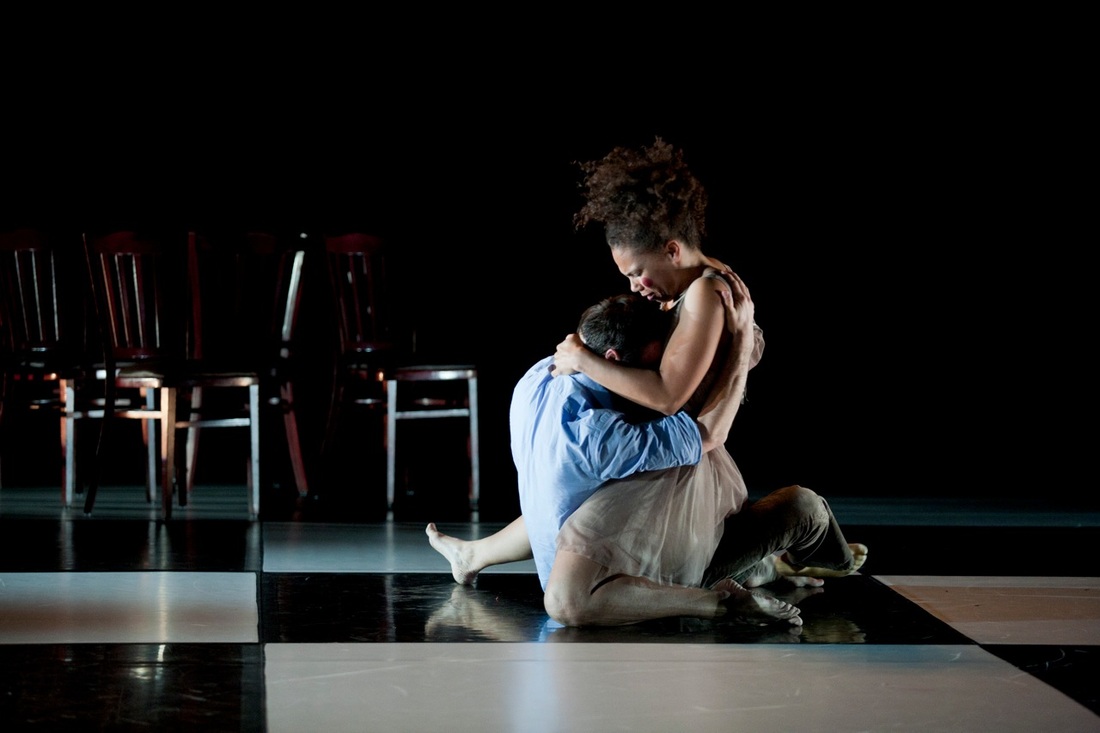
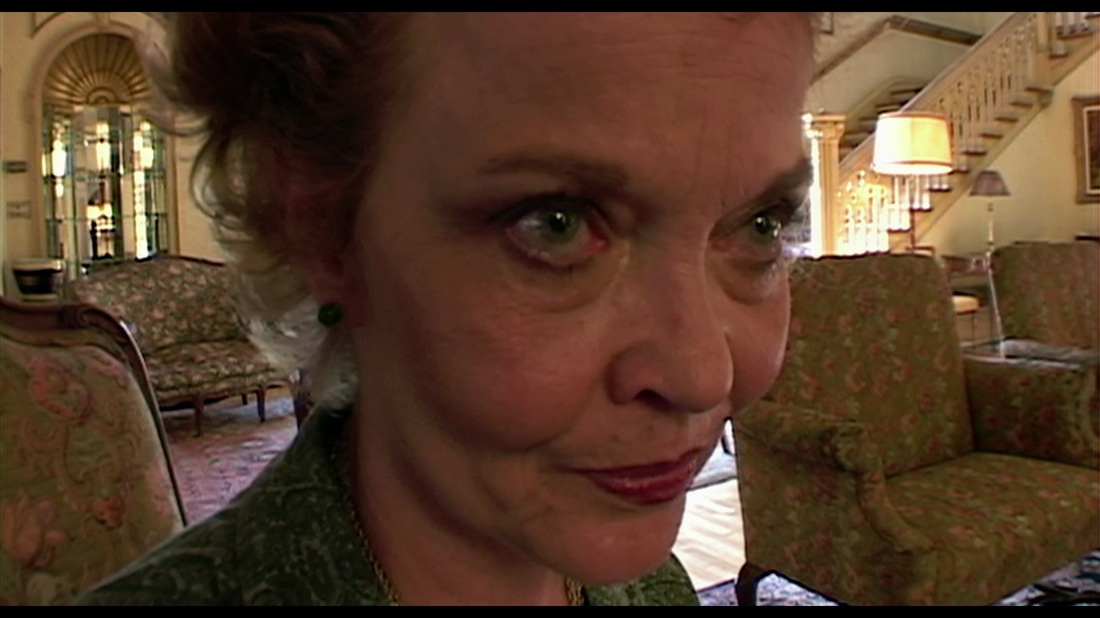
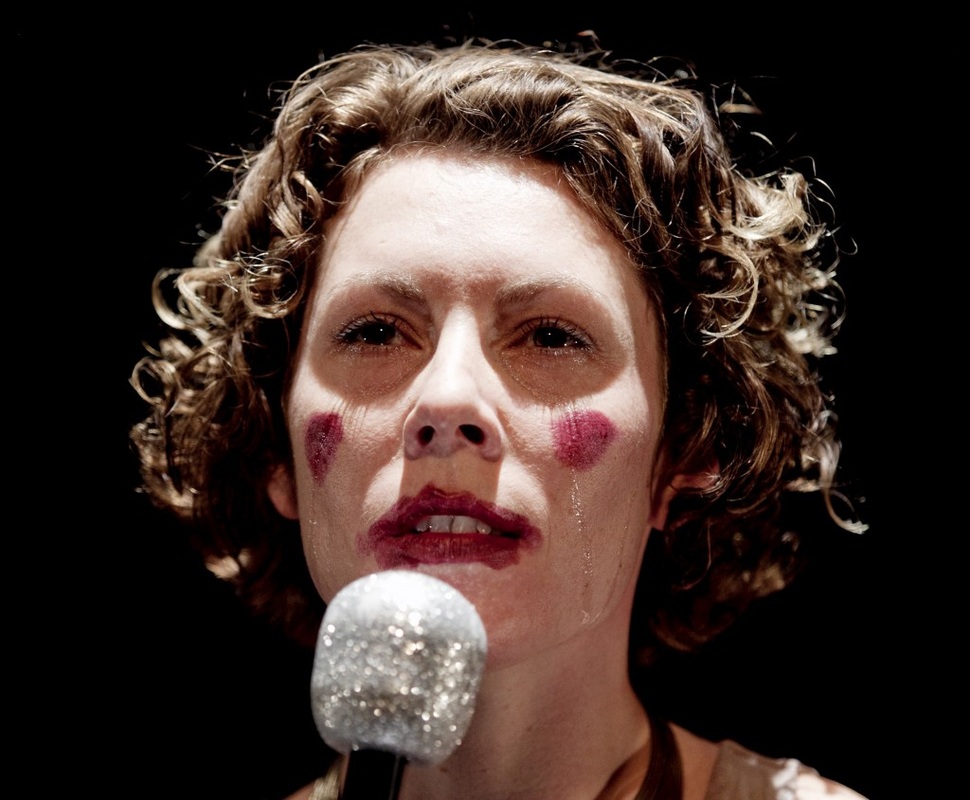
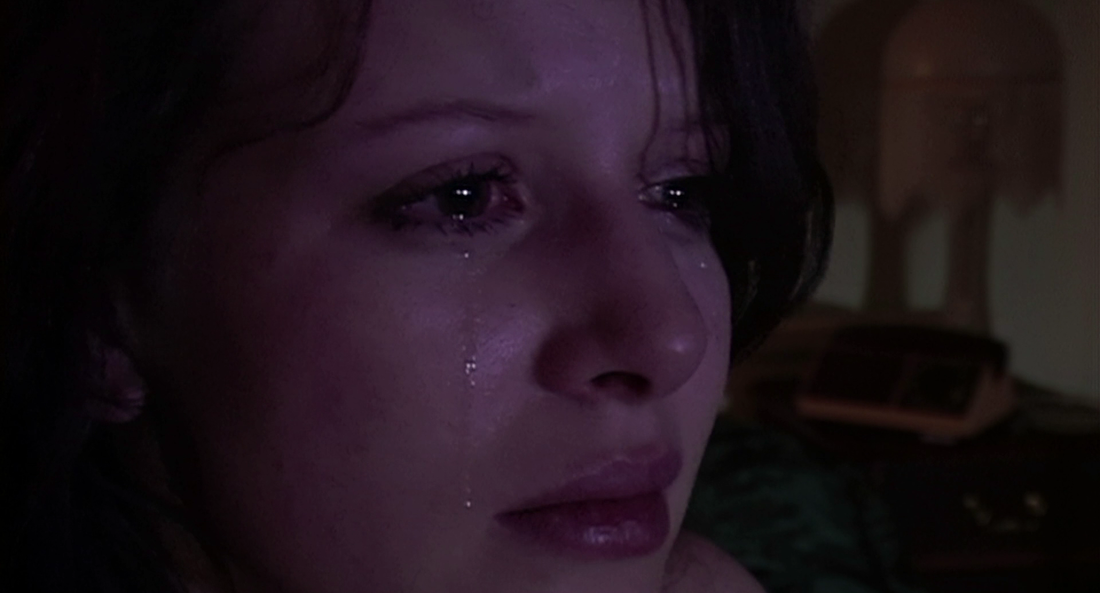
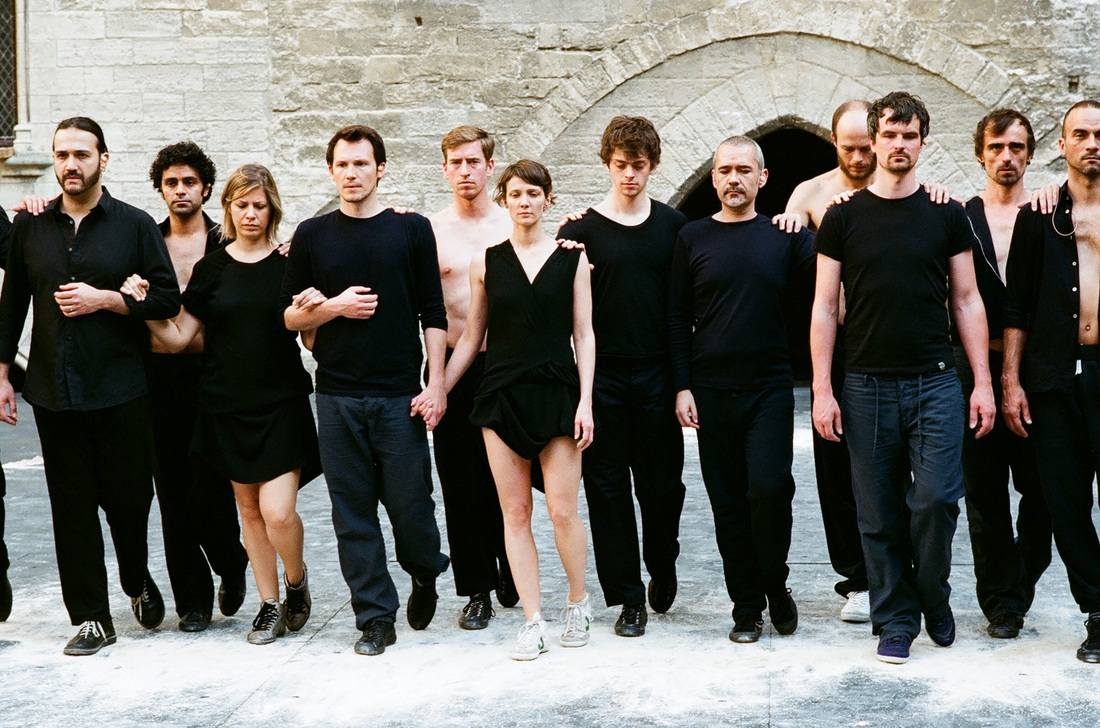
 RSS Feed
RSS Feed